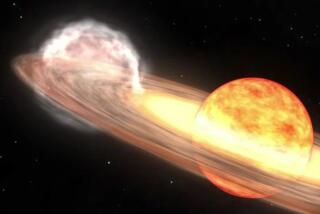Is the Show Over, or Is It Just Beginning? : While Astronomers Watch, a Brilliant Star Is Dying
- Share via
Astronomers throughout the Southern Hemisphere are keeping watch on a brilliant exploding star in the southern sky, wondering if the show is nearly over or just beginning.
Ever since the discovery of the supernova--a giant star going through its final death throes--scientists have been waiting for the star to grow brighter, but it has remained about the same magnitude as when it was first sighted on Feb. 24 by Ian Shelton of the University of Toronto, using the Carnegie Institution’s Las Campanas observatory in Chile.
No one was quite sure exactly what to expect, because supernovae are rarely observed at such an early stage. Generally, astronomers discover that a star has “gone supernova” only by coming across the debris long after the star had exploded.
What makes this supernova so exciting to astronomers is that it is the closest one to Earth since 1604, in the Large Magellanic Cloud, a galaxy so close to the Milky Way that it is considered a companion galaxy.
“It’s something you tell your grandchildren about one day,” said Ealine Sadler, who was at the Cerro Tololo Inter-American Observatory in Chile when the star was discovered.
Possible Explanation
Many astronomers were disappointed when the star did not brighten as quickly as they had expected, but the Royal Greenwich Observatory in England has come up with a possible explanation. It is one of many facilities around the world reporting findings to the Central Bureau for Astronomical Telegrams at the Smithsonian Astrophysical Observatory in Cambridge, Mass.
Scientists with the Royal Observatory said that whether the star brightens or grows dim during the next few days depends on the stage of its evolution at the time it was discovered. Based on historical records of similar events, the proper sequence should be for the supernova to first brighten, then level off, then brighten much more before quieting down.
So if the supernova, known only by the number 1987A, is as young as scientists believe it is, it should suddenly become much brighter around the middle of this month, according to the Royal Observatory. If it is now at its maximum brightness, it should remain there until early July before dying down.
Whatever it does, there seems to be no end to the excitement among astronomers who have seen the supernova, viewed as a once-in-a-lifetime opportunity.
Sadler said astronomers who have been assigned time on telescopes in the Southern Hemisphere dropped whatever they were doing to turn their instruments on the supernova whenever possible.
Star Grows Redder
“Just about everybody would jump for something like this,” she said.
Sadler said she observed the supernova for four or five nights, adding during that period it became redder in color. She said one probable explanation for the change is that the star is enveloping itself in a cloud of gas.
That, too, is of interest to astronomers because it is generally believed that exploding stars are the fuel the universe uses to create new stars and new galaxies.
Meanwhile, astronomers from Johns Hopkins University, who are at the Las Campanas Observatory, said their observations revealed that the supernova resulted from the explosion of a very large star “at least eight times the mass of our sun.”






